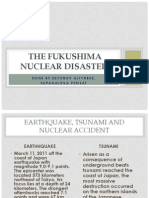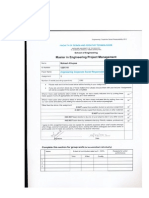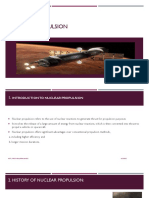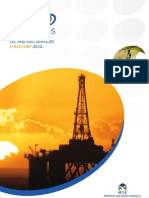0 ratings0% found this document useful (0 votes)
177 viewsFukushima Daiichi Nuclear Disaster
Fukushima Daiichi Nuclear Disaster
Uploaded by
Crisanto Coquia YcoThe Fukushima Daiichi nuclear disaster was caused by an earthquake and tsunami in March 2011 that disabled the plant's safety systems and led to three nuclear meltdowns. The accident released radioactive contamination and forced the evacuation of over 150,000 residents. It was the second worst nuclear accident after Chernobyl. Cleanup is expected to take 30-40 years and cost billions. Investigations found the disaster was foreseeable and safety requirements had been inadequate.
Copyright:
© All Rights Reserved
Available Formats
Download as DOCX, PDF, TXT or read online from Scribd
Fukushima Daiichi Nuclear Disaster
Fukushima Daiichi Nuclear Disaster
Uploaded by
Crisanto Coquia Yco0 ratings0% found this document useful (0 votes)
177 views3 pagesThe Fukushima Daiichi nuclear disaster was caused by an earthquake and tsunami in March 2011 that disabled the plant's safety systems and led to three nuclear meltdowns. The accident released radioactive contamination and forced the evacuation of over 150,000 residents. It was the second worst nuclear accident after Chernobyl. Cleanup is expected to take 30-40 years and cost billions. Investigations found the disaster was foreseeable and safety requirements had been inadequate.
Original Title
Fukushima Daiichi nuclear disaster
Copyright
© © All Rights Reserved
Available Formats
DOCX, PDF, TXT or read online from Scribd
Share this document
Did you find this document useful?
Is this content inappropriate?
The Fukushima Daiichi nuclear disaster was caused by an earthquake and tsunami in March 2011 that disabled the plant's safety systems and led to three nuclear meltdowns. The accident released radioactive contamination and forced the evacuation of over 150,000 residents. It was the second worst nuclear accident after Chernobyl. Cleanup is expected to take 30-40 years and cost billions. Investigations found the disaster was foreseeable and safety requirements had been inadequate.
Copyright:
© All Rights Reserved
Available Formats
Download as DOCX, PDF, TXT or read online from Scribd
Download as docx, pdf, or txt
0 ratings0% found this document useful (0 votes)
177 views3 pagesFukushima Daiichi Nuclear Disaster
Fukushima Daiichi Nuclear Disaster
Uploaded by
Crisanto Coquia YcoThe Fukushima Daiichi nuclear disaster was caused by an earthquake and tsunami in March 2011 that disabled the plant's safety systems and led to three nuclear meltdowns. The accident released radioactive contamination and forced the evacuation of over 150,000 residents. It was the second worst nuclear accident after Chernobyl. Cleanup is expected to take 30-40 years and cost billions. Investigations found the disaster was foreseeable and safety requirements had been inadequate.
Copyright:
© All Rights Reserved
Available Formats
Download as DOCX, PDF, TXT or read online from Scribd
Download as docx, pdf, or txt
You are on page 1of 3
Fukushima Daiichi nuclear disaster
From Wikipedia, the free encyclopedia
Jump to navigationJump to search
"Fukushima nuclear disaster" redirects here. For the incidents at Fukushima Daini,
see Fukushima Daini Nuclear Power Plant.
"2011 Japanese nuclear accidents" redirects here. For other 2011 Japanese nuclear
accidents/incidents, see Fukushima Daini Nuclear Power Plant, Onagawa Nuclear
Power Plant, Tōkai Nuclear Power Plant, and Rokkasho Reprocessing Plant.
This article may be too long to read and navigate comfortably. The readable
prose size is 92 kilobytes. Please consider splitting content into sub-
articles, condensing it, or adding subheadings. (September 2018)
‹ The template Infobox event is being considered for merging. ›
Fukushima Daiichi nuclear disaster
Part of the 2011 Tōhoku earthquake and tsunami
The four damaged reactor buildings (from left: Units 4, 3, 2, and 1) on
16 March 2011. Hydrogen-air explosions in Unit 1, 3, and 4 caused
structural damage. Water vapor/"steam" venting prevented a similar
explosion in Unit 2.[1]
Date 11 March 2011
Location Ōkuma, Fukushima Prefecture, Japan
37°25′17″N 141°1′57″ECoordinates: 37°25′17
Coordinates
″N 141°1′57″E
Outcome INES Level 7 (major accident)[2][3]
Deaths 1 cancer death attributed to radiation exposure by
government panel.[4][5]
Non-fatal 16 with physical injuries due to hydrogen
injuries explosions,[6]
2 workers taken to hospital with possible radiation
burns[7]
The Fukushima Daiichi nuclear disaster (福島第一原子力発電所事故, Fukushima
Dai-ichi ( pronunciation) genshiryoku hatsudensho jiko) was a nuclear accident at
the Fukushima Daiichi Nuclear Power Plant in Ōkuma, Fukushima Prefecture. It was the
most severe nuclear accident since the 1986 Chernobyl disaster, and the only other
disaster to receive the Level 7 event classification of the International Nuclear Event
Scale.[8]
The accident was started by the Tōhoku earthquake and tsunami on Friday, 11 March
2011.[9] On detecting the earthquake, the active reactors automatically shut
down their fission reactions. Because of the reactor trips and other grid problems, the
electricity supply failed, and the reactors' emergency diesel generators automatically
started. Critically, they were powering the pumps that circulated coolant through the
reactors' cores to remove decay heat, which continues to be produced after fission has
ceased.[10] The earthquake generated a 14 m high tsunami that swept over the plant's
seawall and flooded the plant's lower grounds around the Units 1–4 reactor buildings
with sea water, filling the basements and knocking out the emergency generators. [11] The
resultant loss-of-coolant accidents led to three nuclear meltdowns, three hydrogen
explosions, and the release of radioactive contamination in Units 1, 2 and 3 between 12
and 15 March. The spent fuel pool of previously shut-down Reactor 4 increased in
temperature on 15 March due to decay heat from newly added spent fuel rods, but did
not boil down sufficiently to expose the fuel.[12]
In the days after the accident, radiation released to the atmosphere forced the
government to declare an ever-larger evacuation zone around the plant, culminating in
an evacuation zone with a 20 km radius. [13] All told, some 154,000 residents evacuated
from the communities surrounding the plant due to the rising off-site levels of
ambient ionizing radiation caused by airborne radioactive contamination from the
damaged reactors.[14]
Large amounts of water contaminated with radioactive isotopes were released into
the Pacific Ocean during and after the disaster. Michio Aoyama, a professor of
radioisotope geoscience at the Institute of Environmental Radioactivity, has estimated
that 18,000 terabecquerel (TBq) of radioactive caesium 137 were released into the
Pacific during the accident, and in 2013, 30 gigabecquerel (GBq) of caesium 137 were
still flowing into the ocean every day.[15] The plant's operator has since built new walls
along the coast and also created a 1.5 km long "ice wall" of frozen earth to stop the flow
of contaminated water.[16]
While there has been ongoing controversy over the health effects of the disaster, a
2014 report by the United Nations Scientific Committee on the Effects of Atomic
Radiation (UNSCEAR) [17] and World Health Organization projected no increase in
miscarriages, stillbirths or physical and mental disorders in babies born after the
accident.[18] An ongoing intensive cleanup program to both decontaminate affected areas
and decommission the plant will take 30 to 40 years, plant management estimate. [19][4]
On 5 July 2012, the National Diet of Japan Fukushima Nuclear Accident Independent
Investigation Commission (NAIIC) found that the causes of the accident had been
foreseeable, and that the plant operator, Tokyo Electric Power Company (TEPCO), had
failed to meet basic safety requirements such as risk assessment, preparing for
containing collateral damage, and developing evacuation plans. At a meeting in Vienna
three months after the disaster, the International Atomic Energy Agency faulted lax
oversight by the Ministry of Economy, Trade and Industry, saying the ministry faced an
inherent conflict of interest as the government agency in charge of both regulating and
promoting the nuclear power industry.[20] On 12 October 2012, TEPCO admitted for the
first time that it had failed to take necessary measures for fear of inviting lawsuits or
protests against its nuclear plants.[21][22][23][24]
You might also like
- D'Agata - About A MountainDocument236 pagesD'Agata - About A Mountaincristie Strongman50% (2)
- Writing Academic English, Fourth Edition Answer KeyDocument64 pagesWriting Academic English, Fourth Edition Answer KeyLaman100% (2)
- Fukushima Daiichi Nuclear Power Disaster CaseDocument11 pagesFukushima Daiichi Nuclear Power Disaster Caseapi-30870367175% (8)
- Nuclear Engineering Theory and Technology of Commercial Nuclear PowerDocument121 pagesNuclear Engineering Theory and Technology of Commercial Nuclear PowerArthur Alberth0% (1)
- Fukushima DaiichiDocument55 pagesFukushima DaiichiJaganath RaviNo ratings yet
- Nuclear Power in JapanDocument11 pagesNuclear Power in JapanAnup KumarNo ratings yet
- Fukushima Nuclear Disaster AssignmentDocument7 pagesFukushima Nuclear Disaster Assignmentarsalankhan.ali01100% (1)
- J Nucl Med-2011-Dauer-1423-32Document11 pagesJ Nucl Med-2011-Dauer-1423-32Nur AsrhyNo ratings yet
- Log Report 2Document2 pagesLog Report 2Gokul SinghNo ratings yet
- TP of GeomorphologyDocument12 pagesTP of GeomorphologyJean Paul HabimanaNo ratings yet
- A Study of The Fukushima Daiichi Nuclear Accident Process What Caused The Core Melt and Hydrogen Explosion PDFDocument241 pagesA Study of The Fukushima Daiichi Nuclear Accident Process What Caused The Core Melt and Hydrogen Explosion PDFs3dbwNo ratings yet
- Fukushima Nuclear Disaster: Mark HoltDocument15 pagesFukushima Nuclear Disaster: Mark HoltIranurarbaatuljannah100% (1)
- Fukushima Nuclear Power Plant Risk AssessmentDocument11 pagesFukushima Nuclear Power Plant Risk AssessmentNillethVillasantaPontino100% (1)
- Fukushima Daiichi Nuclear Disaster MARCH 11,2011Document22 pagesFukushima Daiichi Nuclear Disaster MARCH 11,2011Muhammad AdiwirawanNo ratings yet
- Iaea International Fact Finding Expert Mission of The Nuclear Accident Following The Great East Japan Earthquake and TsunamiDocument5 pagesIaea International Fact Finding Expert Mission of The Nuclear Accident Following The Great East Japan Earthquake and Tsunamiapi-74128153No ratings yet
- 2013 10 01 Disasters Leadership RebuildingDocument20 pages2013 10 01 Disasters Leadership RebuildingJosé Francisco Fernández FernandezNo ratings yet
- Experiences From the Fukushima DisasterDocument18 pagesExperiences From the Fukushima Disastersidodo7868No ratings yet
- The Fukushima: Nuclear DisasterDocument22 pagesThe Fukushima: Nuclear DisasterPerizat KupagulovaNo ratings yet
- Case Study on Fukushima EEE423 20121037Document10 pagesCase Study on Fukushima EEE423 20121037FARHAN NOOR SHOWROVNo ratings yet
- YR9 Week 2 HomeworkDocument7 pagesYR9 Week 2 Homeworkmalekashrafomar2No ratings yet
- Engineering Corporate Social ResponsibilityDocument15 pagesEngineering Corporate Social ResponsibilityMahesh KhupseNo ratings yet
- ICCAUA2022EN0018-Mohamad ZayatDocument11 pagesICCAUA2022EN0018-Mohamad ZayatMohamad ZayatNo ratings yet
- Nuclear Power in Japan: Fukushima and After: Richard TanterDocument89 pagesNuclear Power in Japan: Fukushima and After: Richard TanterBogdanNo ratings yet
- Japan Earthquake, Tsunami and Nuclear Crisis: / Nætʃ.ɚ. LD Ɪ Zæs - TɚDocument6 pagesJapan Earthquake, Tsunami and Nuclear Crisis: / Nætʃ.ɚ. LD Ɪ Zæs - TɚLillis SarahNo ratings yet
- Powerplant AssignmentDocument10 pagesPowerplant AssignmentFaysal Qadeer KhanNo ratings yet
- Assignment # 1 Japan Nuclear Explosion Safety Report: Submitted ToDocument2 pagesAssignment # 1 Japan Nuclear Explosion Safety Report: Submitted ToShahzeb TariqNo ratings yet
- Comparison of The Accident Process, Radioactivity Release and Ground Contamination Between Chernobyl and Fukushima-1Document6 pagesComparison of The Accident Process, Radioactivity Release and Ground Contamination Between Chernobyl and Fukushima-1Anirudha BarmanNo ratings yet
- Fukushima Daiichi Nuclear IncidentDocument22 pagesFukushima Daiichi Nuclear IncidentManishitaNo ratings yet
- DisasterDocument4 pagesDisasterPratik PatelNo ratings yet
- Olatunde J Aladesote Ryan Carter, and Petronella James-OkekeDocument7 pagesOlatunde J Aladesote Ryan Carter, and Petronella James-OkekeSharen ArdyanaNo ratings yet
- Case Study On Nuclear AccidentDocument11 pagesCase Study On Nuclear AccidentAman DangwalNo ratings yet
- The Fukushima Nuclear AccidentDocument11 pagesThe Fukushima Nuclear AccidentMariano MartinezNo ratings yet
- Summarize Fukushima VideoDocument3 pagesSummarize Fukushima VideoBan RaedNo ratings yet
- Assignment No. 1 The Fukushima Japan Nuclear AccidentDocument4 pagesAssignment No. 1 The Fukushima Japan Nuclear AccidentYADNESH CHAUDHARINo ratings yet
- Nuclear Catastrophe in JapanDocument12 pagesNuclear Catastrophe in JapanshreyjainiNo ratings yet
- Paper - The Fukushima Daiichi Nuclear DisasterDocument12 pagesPaper - The Fukushima Daiichi Nuclear DisasterMaxime GoossensNo ratings yet
- Fukushima Daiichi Nuclear Power Plant Accident Impacton Okuma Japanand Assessmentof Ethics Risk Analysisand MitigationDocument10 pagesFukushima Daiichi Nuclear Power Plant Accident Impacton Okuma Japanand Assessmentof Ethics Risk Analysisand MitigationzhoujingyaoscribdNo ratings yet
- Nuclear Safety Fundamentals and Case StudiesDocument30 pagesNuclear Safety Fundamentals and Case StudiesJahin Tasfia ArthyNo ratings yet
- Supercasestudy 02Document17 pagesSupercasestudy 02MUKUL MUDGALNo ratings yet
- Case Study FukushimaDocument14 pagesCase Study Fukushimawaleedhassan61No ratings yet
- ISEP Report On Japan's Energy Shift Since March 11 English Version No.2Document12 pagesISEP Report On Japan's Energy Shift Since March 11 English Version No.2環境エネルギー政策研究所No ratings yet
- Fukushima Disaster: How a Tsunami Unleashed Nuclear DestructionFrom EverandFukushima Disaster: How a Tsunami Unleashed Nuclear DestructionRating: 5 out of 5 stars5/5 (1)
- Reaction Paper KoDocument7 pagesReaction Paper KoJerenmie De Jesus ChuaNo ratings yet
- Friday, 11 March: 1446 Local Time (0546 GMT)Document7 pagesFriday, 11 March: 1446 Local Time (0546 GMT)manziltakformeNo ratings yet
- Assessment of Individual Radionuclide Distributions From The Fukushima Nuclear Accident Covering Central-East JapanDocument4 pagesAssessment of Individual Radionuclide Distributions From The Fukushima Nuclear Accident Covering Central-East JapanJudithNRNo ratings yet
- Japan's Deadly Game of Nuclear Roulette 2004-05-23 (!!!)Document6 pagesJapan's Deadly Game of Nuclear Roulette 2004-05-23 (!!!)GodIsTruthNo ratings yet
- Fukushima Nuclear Disaster: by Timothé and LucasDocument10 pagesFukushima Nuclear Disaster: by Timothé and LucasTimoNo ratings yet
- Engnews01 1302521667PDocument4 pagesEngnews01 1302521667PshuusakuNo ratings yet
- Int J Japanese Sociology - 2012 - FUNABASHI - Why The Fukushima Nuclear Disaster Is A Man Made CalamityDocument11 pagesInt J Japanese Sociology - 2012 - FUNABASHI - Why The Fukushima Nuclear Disaster Is A Man Made Calamityathithiyavs102No ratings yet
- RadionuclearDocument2 pagesRadionuclearCNo ratings yet
- Running Head: Tohoku EarthquakeDocument9 pagesRunning Head: Tohoku Earthquakeapi-300550974No ratings yet
- FukashimapolicyDocument17 pagesFukashimapolicyapi-413768025No ratings yet
- Facts and Lessons of The Fukushima Nuclear Accident and Safety ImprovementDocument80 pagesFacts and Lessons of The Fukushima Nuclear Accident and Safety Improvementkerusacba_2011No ratings yet
- BiologyDocument2 pagesBiologyapi-298535039No ratings yet
- Fukushima Fallout: Unveiling the Truth behind the 2011 Nuclear DisasterFrom EverandFukushima Fallout: Unveiling the Truth behind the 2011 Nuclear DisasterNo ratings yet
- Art 3A10.1007 2Fs00024 012 0615 0Document7 pagesArt 3A10.1007 2Fs00024 012 0615 0alifNo ratings yet
- The Asia-Pacific Journal: Japan Focus: In-Depth Critical Analysis of The Forces Shaping The Asia-Pacific... and The WorldDocument3 pagesThe Asia-Pacific Journal: Japan Focus: In-Depth Critical Analysis of The Forces Shaping The Asia-Pacific... and The WorldDewi SekarsariNo ratings yet
- 003 An overview of the decision-making process and governing institutionsDocument5 pages003 An overview of the decision-making process and governing institutionsjm2720289763No ratings yet
- Effects Fukushima RosenDocument14 pagesEffects Fukushima RosenfemalefaustNo ratings yet
- By: Grade:: Mariam Sayyar 12Document4 pagesBy: Grade:: Mariam Sayyar 12Maryoom SalmanNo ratings yet
- Nuclear AccidentsDocument10 pagesNuclear AccidentsAmisha BhasinNo ratings yet
- Crisis Without End: The Medical and Ecological Consequences of the Fukushima Nuclear CatastropheFrom EverandCrisis Without End: The Medical and Ecological Consequences of the Fukushima Nuclear CatastropheNo ratings yet
- My Nuclear Nightmare: Leading Japan through the Fukushima Disaster to a Nuclear-Free FutureFrom EverandMy Nuclear Nightmare: Leading Japan through the Fukushima Disaster to a Nuclear-Free FutureRating: 3 out of 5 stars3/5 (1)
- Istruktura Silabus HAUDocument16 pagesIstruktura Silabus HAUCrisanto Coquia YcoNo ratings yet
- HydrogenDocument1 pageHydrogenCrisanto Coquia YcoNo ratings yet
- Core Meltdowns in Units 1Document2 pagesCore Meltdowns in Units 1Crisanto Coquia YcoNo ratings yet
- Arrival of TsunamiDocument1 pageArrival of TsunamiCrisanto Coquia YcoNo ratings yet
- Safety Test: Excitation Magnetic FieldDocument1 pageSafety Test: Excitation Magnetic FieldCrisanto Coquia YcoNo ratings yet
- Test Delay and Shift ChangeDocument2 pagesTest Delay and Shift ChangeCrisanto Coquia YcoNo ratings yet
- Reactor Conditions Priming The AccidentDocument1 pageReactor Conditions Priming The AccidentCrisanto Coquia YcoNo ratings yet
- Interactive Table of Contents: Page NumberDocument1 pageInteractive Table of Contents: Page NumberCrisanto Coquia YcoNo ratings yet
- B. Pagkakaiba NG Dyalekto (Document2 pagesB. Pagkakaiba NG Dyalekto (Crisanto Coquia YcoNo ratings yet
- Reactor Cooling After ShutdownDocument1 pageReactor Cooling After ShutdownCrisanto Coquia YcoNo ratings yet
- Interactive Table of Contents: Page NumberDocument1 pageInteractive Table of Contents: Page NumberCrisanto Coquia YcoNo ratings yet
- Domain 2: Linguistics of The Target LanguageDocument1 pageDomain 2: Linguistics of The Target LanguageCrisanto Coquia YcoNo ratings yet
- Assessment of The Extra Capacity Required of Alt Energy Power System - FULL REPORT v7Document1,000 pagesAssessment of The Extra Capacity Required of Alt Energy Power System - FULL REPORT v7simon michauxNo ratings yet
- Guide To RebuttalDocument4 pagesGuide To Rebuttaltalha.khan77498No ratings yet
- Towards Green Energy WorksheetDocument5 pagesTowards Green Energy Worksheetkajal.ladeNo ratings yet
- RE ShieldingDocument32 pagesRE ShieldingWaleed TayyabNo ratings yet
- FR Mar Report 2019 PDFDocument526 pagesFR Mar Report 2019 PDFSantosh Hiredesai100% (1)
- Powering Ontario For The Next Half-Century: Refurbishing DarlingtonDocument8 pagesPowering Ontario For The Next Half-Century: Refurbishing DarlingtonMike LassaNo ratings yet
- Subject Catagories ETDE PDFDocument67 pagesSubject Catagories ETDE PDFmartinimartiiniNo ratings yet
- EnvMangmt MCQ N TheoryDocument104 pagesEnvMangmt MCQ N Theorypooja pillaiNo ratings yet
- V INPPS Program - V. UDocument7 pagesV INPPS Program - V. UbugrauzgNo ratings yet
- Sindh Investment HandbookDocument206 pagesSindh Investment HandbookBarrister Asghar KhanNo ratings yet
- Wind and WaterDocument225 pagesWind and WaterbugstermanNo ratings yet
- Nuclear PropulsionDocument90 pagesNuclear PropulsionAnush SainiNo ratings yet
- Te 1203 PRN PDFDocument352 pagesTe 1203 PRN PDFgokonkNo ratings yet
- ĐỀ LUYỆN TH HỌC SINH GIỎI ĐỀ 9 10 HSDocument10 pagesĐỀ LUYỆN TH HỌC SINH GIỎI ĐỀ 9 10 HSmh3804325No ratings yet
- CIBSE Journal 2016 10Document80 pagesCIBSE Journal 2016 10tyberius7No ratings yet
- Supplemental Report Contract W Schneider ElectricDocument101 pagesSupplemental Report Contract W Schneider ElectricRecordTrac - City of OaklandNo ratings yet
- Assignment 1Document5 pagesAssignment 1Teoh Wong WeiNo ratings yet
- Gs SectorsDocument8 pagesGs Sectorsshakeel akhterNo ratings yet
- Dawood Public School Course Outline 2019-2020 Geography Grade VIIIDocument18 pagesDawood Public School Course Outline 2019-2020 Geography Grade VIIIShahla AliNo ratings yet
- Pocket Guide ReactorsDocument2 pagesPocket Guide ReactorsRanti WarfiNo ratings yet
- Rtu Kota SyllabusDocument11 pagesRtu Kota Syllabusnamansharmao927No ratings yet
- Turkey Oil Gas and Energy DemandDocument16 pagesTurkey Oil Gas and Energy DemandElman AskerovNo ratings yet
- PAEC and Other AbbriviationsDocument3 pagesPAEC and Other AbbriviationsSALMAN SAEEDNo ratings yet
- 3902 Engl 2012 111 PDFDocument67 pages3902 Engl 2012 111 PDFvcock6109No ratings yet
- Caithness Oil and Gas DirectoryDocument28 pagesCaithness Oil and Gas DirectoryUmar Bin Rashid100% (1)
- Full Download Introduction To Sustainable Energy Transformation 1st Edition Henryk Anglart PDFDocument57 pagesFull Download Introduction To Sustainable Energy Transformation 1st Edition Henryk Anglart PDFtohamiadresa100% (3)
- ICGLetterDocument16 pagesICGLettertineyintharvoiceNo ratings yet





































































































